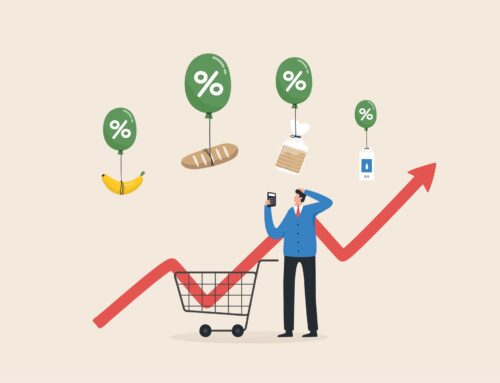
In 1960, a gallon of conventional whole milk was 31 cents, and today it’s $3.77 on average.[1] A few dollars might not seem like much, but that’s a 1,116% increase. Now that we’re seeing high inflation, the buying power of your money – including your retirement savings – could be seriously impacted. When calculating how much money you need to retire, consider what you’re left with after inflation.
The Eroding Effects of Inflation
We’ve seen sustained inflation for some time now, and no one knows when it will end. Year-over-year inflation was 7% in December, 6.8% in November, [2] and 8.6% in October.[3] You’ve likely noticed price increases recently, but have you considered how this will change your retirement finances in the long term? For example, after 10 years of 7% inflation, $1 million would be worth about half – $508,350. Even moderate inflation has a significant effect over time: After 20 years with a 2% inflation rate, $1,000,000 would only have the buying power of $672,971.[4]
When Will It End?
The short answer is that no one knows. Many factors influence inflation, including supply chain disruptions, labor shortages, and monetary policy. Recently, energy and food prices, used cars, furniture, and rent have increased more than other goods and services. In December, 49% of small businesses said they planned to raise prices in the next three months, according to the National Federal of Independent Business.
Inflation in the Past
Inflation can hurt purchasing power, which can weigh down economic growth. The last time the inflation rate was over 5%, the U.S. was in the Great Recession.[5] Some economists predict a 1970s style stagflation in this decade since we also saw higher energy prices and unemployment in 2021.[6] Inflation was as high as 14.5% in 1980.[7] To put it in concrete terms, the buying power of $100 in 1960 now has the buying power of $11.24.[8]
[2] https://www.cnbc.com/2022/01/12/cpi-december-2021-.html
[3] https://www.cnbc.com/2021/12/10/consumer-price-index-november-2021.html
[4] https://www.buyupside.com/calculators/inflationjan08.htm
[5] https://www.fool.com/investing/2021/08/28/stock-market-crash-likely-5-data-points-of-concern/
[6] https://qz.com/2068772/why-economists-are-talking-about-stagflation/
[7] https://www.federalreservehistory.org/essays/great-inflation
[8] https://westegg.com/inflation/infl.cgi?money=100&first=1960&final=2020
The commentary on this blog reflects the personal opinions, viewpoints, and analyses of BML Wealth Management’s employees providing such comments and should not be regarded as a description of advisory services provided by West Wealth Group, LLC. The views reflected in the commentary are subject to change at any time without notice. Nothing on this blog constitutes investment advice. Any mention of a particular security and related performance data is not a recommendation to buy or sell that security. Investing involves risk, including the potential loss of principal. No investment strategy can guarantee a profit or protect against loss in periods of declining values. Past performance is no guarantee of future returns.
Investment advisory services through West Wealth Group, LLC, an SEC Registered Investment Adviser. BML Wealth Management and West Wealth Group, LLC are affiliated entities. Insurance Services are offered through BML Wealth & Insurance Services, California Insurance License #0M15550.
We do not provide tax or legal advice, all individuals are encouraged to seek guidance from qualified professionals regarding their personal situation. Any references to protection benefits or steady and reliable income streams in this guide refer only to fixed insurance products. They do not refer, in any way, to securities or investment advisory products.






